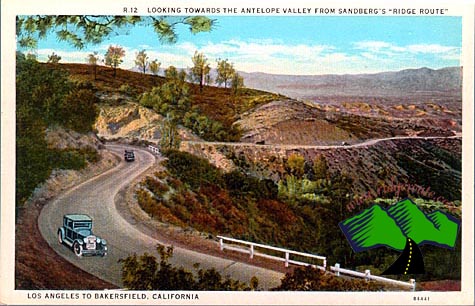
Discovery,
Find, Beginnings, Early, Challenge,
Breaking, Paving,
Residents, Tourists,
Kelly's, Conclusion
Beginnings
of the State Highway System
At
this point it is necessary to review early events which to the Ridge
Route's birth. In 1895, the State Bureau of highways was created. Governor
James H. Budd appointed three highway commissioners, R.C. Irvine of
Sacramento, Marsden Manson of San Francisco and L. Maude of Riverside.
These three officials purchased a team of horses and a buckboard wagon
and proceeded, during the next year and a half, to cover the state,
logging some 7,000 miles. Upon their return they submitted a report
to the governor recommending a system of state highways which would
connect all large centers of population. Every county seat would be
reached. Their recommendation included the utilization of existing county
roads to the fullest possible extent.
Specifically was suggested a direct route from Los Angeles to the San
Joaquin Valley to replace the roundabout Midway Route.
The California Legislature of 1897 dissolved the Bureau of Highways
and created a Department of Highways. The members of the new department
made exhaustive studies of road construction practices and economics.
Members of the department toured Europe to observe methods used in England,
France and other countries. (Even then, justified extended trips on
tax dollars!)
Their findings on such factors as drainage, and roadbed and pavement
construction, were based on fundamental engineering policies. At the
outset, modern highway development in California was on a firm foundation.
In 1907, the Department of Engineering was organized, but due to lack
of funds, no road construction began. A resolution in 1911 designated
three men as an executive committee to the Department of Engineering
to be known as the California Highway Commission. These three gained
immediate control over all state road and highway activities, with the
Tehachapi receiving special priority. Before the Tehachapi barrier succumbed
to the Ridge Route, there was a strong political movement afoot to carve
California into two states.
In 1909, the State authorized a bond issue of $18 million for the purpose
of constructing a state highway system. The voters approved the bonds
the following year. Los Angeles purchased the bonds when the Commission
was unable to market the securities in the East.
In 1912, an intensive survey was begun with 18 months taken in
laying out the Ridge Route The preliminary study, made by W. Lewis Clark,
Division Engineer at Los Angeles, dissipated all doubt as to the feasibility
of a direct route over the mountains. To Highway Commissioner N.D. Darlington
of Los Angeles belongs the chief credit for the selection and the construction
of the route.
Since travel to the south first began there had been only two routes
followed. The Tehachapi, (midway route) mentioned earlier which was
due east from Bakersfield to Mojave, then south through Lancaster to
access Mint or Boquet canyons. The other being the '"Tejon Pass
Route," which used an old wagon road to climb up the Grapevine
grade from the Bakersfield side to Quail Lake (today Hwy 138), then
east roughly following the San Andreas rift to the head of either San
Francisquito (Tumer Pass) or Boquet canyons. The Tejon Route was considerably
shorter than the Tehachapi Route but neither pass could be called direct,
for both curved widely to the east to reach the heads of the canyons
while the objective point was at most due south. It may be of interest
to note that the "Grapevine" refers to the 6.5 mile stretch
of road between Fort Tejon and the bottom of the mountain giving entrance
into the San Joaquin Valley'"
click
here for next page









